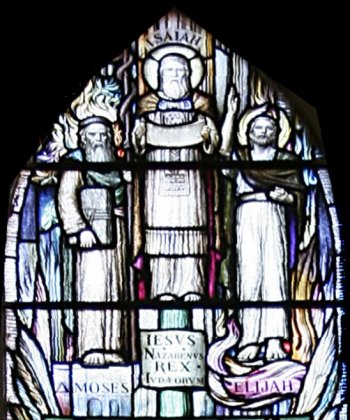
The top of the central light depicts Moses and Elijah on either side of the central figure of Isaiah. The appearance of Moses and Elijah together, especially in this panel above the central figure of the Crucified Christ, is a powerful reminder of the presence of these two central Old Testament figures with Christ at the Transfiguration. Both Moses and Elijah are mentioned in the Gospels more often than any other Old Testament figures.
Moses lived in the 13th century BC and is depicted here as an old man, carrying the Book of the Law. Moses is of central importance in the Hebrew tradition, where he is seen as the original lawgiver, the visionary leader, the deliverer of his people, and as a prophet who had spoken directly with God. The Law of Moses was a defining characteristic of the Israelites, and the mission of Jesus is seen as both fulfilling and transcending this law.
Elijah is a different, and probably even more charismatic figure in the popular mind of the time. He lived in the 9th century, BC, and was the most wonderful prophet of the Old Testament. He is depicted here as a younger man, with his hand raised as a blessing, or as a warning. He undoubtedly presented as a somewhat wild and colourful figure, wearing a garment made of hair with a leather girdle, living in caves and clefts in the mountains, and appearing swiftly and leaving as quickly. He came to denounce the apostacy of Israel and to prohesy a long drought in the land. There are stories of miraculous feedings and of the restoration to life of the child of the widow who gave him shelter.